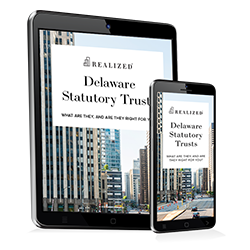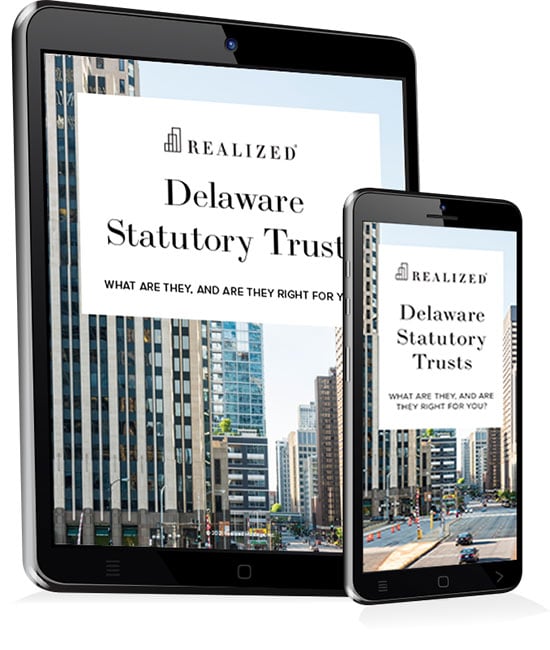
DST is an abbreviation for Delaware Statutory Trust, a legal entity constructed under Delaware law. Despite the name, neither the property nor the investors need to be located in Delaware. In a DST, each investor has an ownership interest in the Trust, which in turn owns the property. Investors are known as “beneficiaries” of the Trust. For these reasons, the security that an investor in a DST owns are called “beneficiary interests.” The IRS treats DST beneficiary interests as direct property ownership, thus qualifying for a 1031 exchange.
What is a 1031 Exchange?
A 1031 exchange refers to a tax deferral strategy used by real estate investors in which funds from the sale of an investment property are used to buy like-kind property. 1031 exchanges allow you to defer capital gains taxes on the sale of your assets, which helps you retain your wealth and create a diversified investment portfolio.
Regarding DSTs, 1031 exchanges allow you to add high-dollar properties to your portfolio. DSTs give investors with limited funds the ability to obtain commercial properties like retail spaces, apartment complexes, and industrial facilities. Once you have passive ownership in one of these properties, you can continue using 1031 exchanges to defer tax liability and grow your wealth by investing in additional high-end assets.
Understanding DSTs
Key IRS guidelines for a DST to qualify under Section 1031 for a like-kind exchange include:
Unlimited beneficiaries, though generally capped at 499 in practice.- Material decisions are made by the Trustee of the DST, rather than by the investors.
- The DST is a passive holder of real estate. Trustees have minimal powers, and beneficiaries (investors) have no powers concerning property operations.
Structural advantages of DSTs include:
- Limited Liability. The DST structure shields investors from personal liabilities beyond the amount of their investment, similar to an LLC or corporation.
- Bankruptcy Remote. The DST structure provides protections against creditors pursuing individual investors for the DST’s debts. It also prohibits an individual investor from placing liens on the property of a DST, giving protections to mortgage lenders and other beneficiaries.
- Control. Major decisions of a DST are made by a single Trustee, eliminating concerns or disagreements between investors.
- Single Borrower. The DST owns 100% of the property and serves as the sole borrower, which makes the process of obtaining a mortgage much simpler.
- Permit a Large Number of Investors. DSTs may have an unlimited number of beneficiaries (though typically capped at 499), allowing for the purchase of institutional quality properties, spread across more investors, thus offering lower investment minimums.
- Pre-Packaged Investments. Typically, the properties of a DST have been acquired and the mortgage put in-place, before it’s offer to investors. This makes it relatively simple for investors to use the 1031 exchange funds to purchase one or more fractional, DST investments.
Despite its many advantages, the DST structure does have its limitations. In order to qualify for 1031 exchange purposes, DSTs are subject to certain prohibitions. They are:
- Once the DST is closed, investors are not allowed to make additional capital contributions;
- The Trustee cannot renegotiate terms of existing loans nor borrow any new funds;
- When a property that is owned by a DST is sold, the Trustee must return these proceed to the investors and cannot invest them in another property;
- Capital expenditures the DST can make on the properties it owns are limited to (a) normal repair and maintenance, (b) non-structural improvements and (c) those required by law;
- Cash held by the DST between distributions to the investors may only be invested in short-term debt securities, like US Treasury bills;
- All cash, other than reserves, must be regularly distributed to the Beneficiaries; and
- The Trustee cannot enter into new leases or renegotiate current leases.
Fractional property investments through DSTs are an attractive option for many 1031 exchange investors. The structure allows investors to participate in larger, higher-quality assets than they may otherwise be able to invest in. Because they are pre-packaged, it makes the process of investing and meeting exchange requirement timelines relatively simple for investors. DSTs do have their limitations and are generally best suited for investors seeking a longer-term, passive investment.
This material is for general information and educational purposes only. Information is based on data gathered from what we believe are reliable sources. It is not guaranteed as to accuracy, does not purport to be complete and is not intended to be used as a primary basis for investment decisions.
Realized does not provide tax or legal advice. This material is not a substitute for seeking the advice of a qualified professional for your individual situation. Costs associated with a 1031 transaction may impact investor’s returns and may outweigh the tax benefits. An unfavorable tax ruling may cancel deferral of capital gains and result in immediate tax liabilities. No public market currently exists and one may never exist. DST programs are speculative and suitable only for Accredited Investors who do not anticipate a need for liquidity or can afford to lose their entire investment. All investments have an inherent level of risk. The value of your investment will fluctuate with the value of the underlying investments. You could receive back less than you initially invested and there is no guarantee that you will receive any income.



